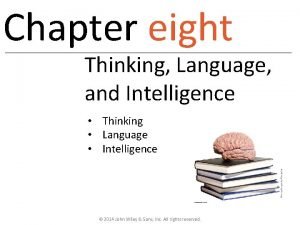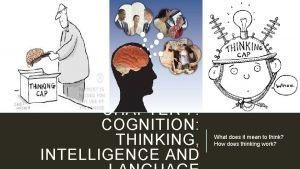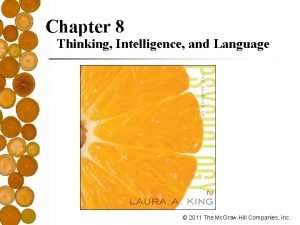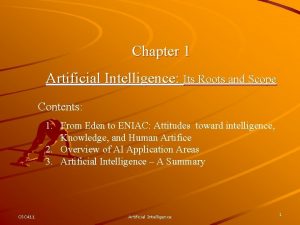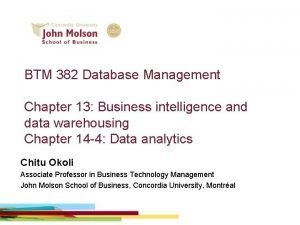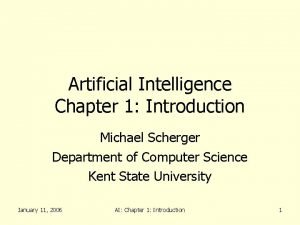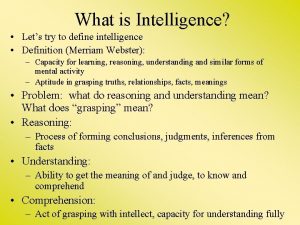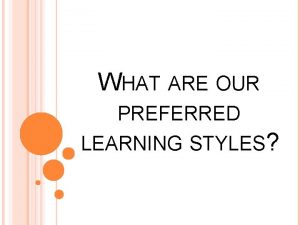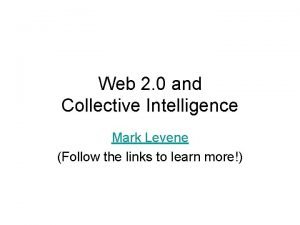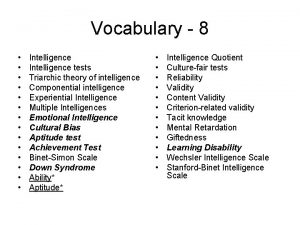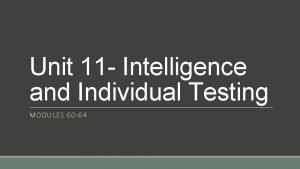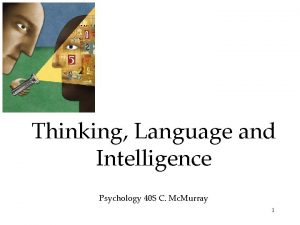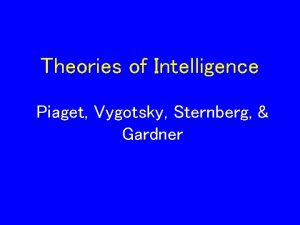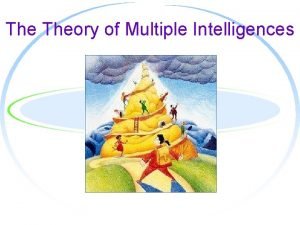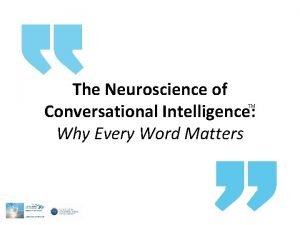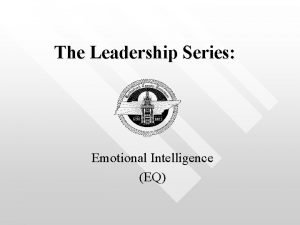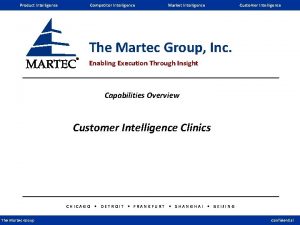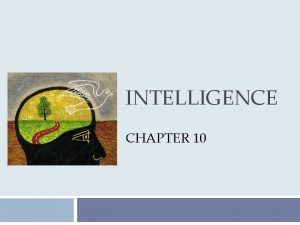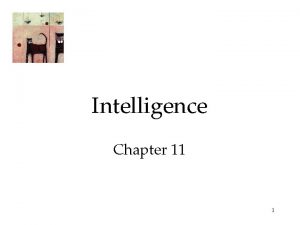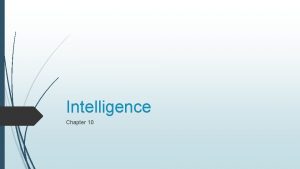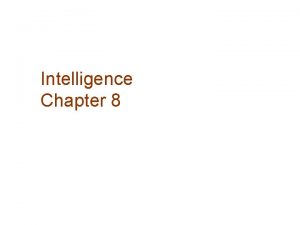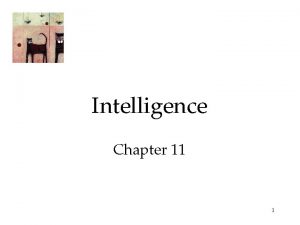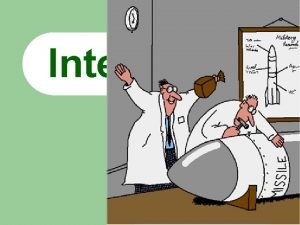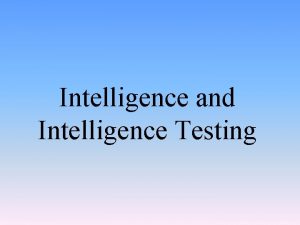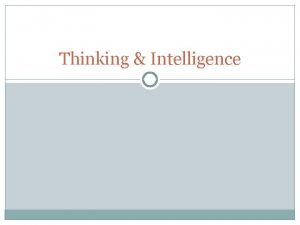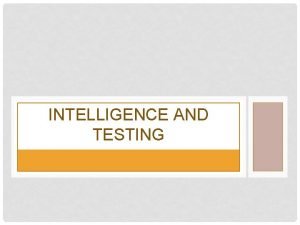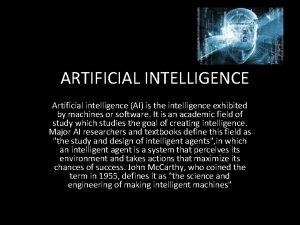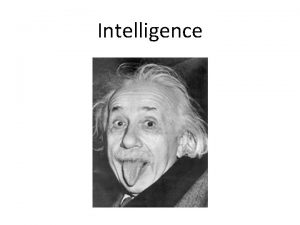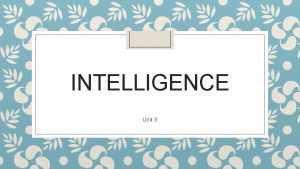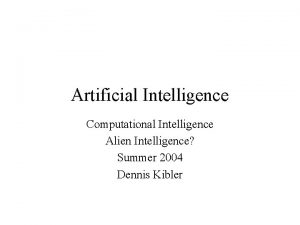Chapter 11 Intelligence What is intelligence Intelligence is













































- Slides: 45

Chapter 11: Intelligence

What is intelligence? Intelligence is a socially constructed concept, not a thing. IQ (intelligence quotient) is not fixed or objective – Don’t reify intelligence Intelligence – mental ability to learn from experience, solve problems, and use knowledge to adapt new situations.

Theories of Intelligence Charles Spearman (early 1900’s) Noticed scores on tests of cognitive abilities were positively correlated – People who do well on one do well on others. Used factor analysis – a statistical method used to show the relationship between variables in intelligence. Believed that there was a single intelligence (general intelligence) called the g factor – If you were intelligent in one area, you were intelligent in other areas Idea of a general mental capacity expressed by a single score

Theories of Intelligence L. L. Thurstone Believed that Spearman oversimplified intelligence – one type of intelligence was not enough. Did not rank his subjects on a single intelligence scale, but found correlations in clusters of primary mental abilities Believed that each person has seven primary mental abilities – sets of independent abilities that each person possesses in varying degrees

Theories of Intelligence - L. L. Thurstone’s 7 Primary Mental Abilities: • Word fluency • Verbal comprehension • Spatial ability • Perceptual speed • Numerical ability • Inductive reasoning • Memory Small tendency for those who excelled in one cluster to score well on the others –some evidence of g-factor

Theories of Intelligence Howard Gardner – Multiple Intelligences All people possess a number of intellectual potentials (intelligences), each of which involves a different set of skills Based his theory on people who suffered traumatic brain injuries – damage to one area does not affect all cognitive abilities Studied people with savant syndrome – cognitive impairments in certain areas but have one or more abilities that are displayed on a genius level


Gardener’s Multiple Intelligences

Theories of Intelligence Robert Sternberg –Triarchic Theory of Intelligences Consists of 3 types of intelligences; • Analytical Intelligence (book smarts) – person’s accumulated knowledge gained through school • Creative Intelligence – ability to generate new ideas and adapt to new situations • Practical Intelligence – (street smarts) ability to interact with one’s environment – everyday tasks

Emotional Intelligence The ability to perceive, understand, manage, and use emotions Four components: • Perceive emotions (recognize them in faces, music, stories) • Understand emotions (predict them and how they change and blend) • Manage emotions (how to express them in varied situations) • Use emotions to enable adaptive or creative thinking

Emotional Intelligence Emotionally Can intelligent people are self-aware read others’ emotions Know what to say in certain situations Have exhibited modestly better job performance Often are more successful in career, marriage, and parenting situations

Creativity Ability to generate novel ideas or products - often goes hand-inhand with intelligence Convergent thinking – narrowing down a single best solution or answer to a problem (tested by intelligence tests) Divergent thinking – Ability to generate multiple solutions to a given problem – “think outside the box”

Creativity Five Components of creativity: • Expertise • Imaginative thinking skills • Venturesome personality • Intrinsic motivation • Creative environment

Brain size and Complexity There is a slight positive correlation between brain size and intelligence scores Intelligence is due to the development of neural communications in response to the environment Highly intelligent people die with more synapses and gray matter

Perceptual and Neurological Speed People who perceive stimuli quickly tend to score somewhat higher on intelligence tests People who score high on intelligence tests tend to retrieve information from memory more quickly

Assessing Intelligence is whatever intelligence tests measure.

Assessing Intelligence – Alfred Binet Modern intelligence testing - beginning of the 20 th century, French government required all children to attend school. Alfred Binet – hired to study differences between children’s intellect and identify children needing special attention. Believed that intelligence can be determined by a mathematical formula. Categorized correctly items by age that a typical child could respond

Assessing Intelligence – Alfred Binet Developed mental age – the chronological age typical of a given level of performance When chrono. age & mental are equal, considered “regular” intelligence Problem – as one gets older, mental age does not change, causing intelligence scores to decrease Binet feared results would be used to label children and limit their opportunities.

Assessing Intelligence – Lewis Terman Stanford University professor noticed that Binet’s IQ test worked poorly with California children Adapted and revised Binet’s test – added items for adults and revised the scoring procedure Name Most this revision the Stanford-Binet widely used intelligence test until the Weschler test came along

Assessing Intelligence William Stern - German psychologist who developed the formula for IQ or Intelligence Quotient IQ = Mental Age ÷ Chronological Age x 100 • Most 85 -114 = Average (68% of test takers) • 115 -129 = Above average • 130 -144 = Gifted (2. 3% of test takers) • 145 -159 = Genius (less than 1% of test takers) • 70 or lower = intellectually challenged current intelligence tests no longer compute an IQ

Normal Distribution of Intelligence Scores

Modern Tests of Mental Abilities Aptitude tests – intended to predict your ability to learn a new skill (SAT, ACT, GRE) Achievement tests - intended to reflect what you have learned (Exams in school, AP test) Factors that influence your score: Your achieved vocabulary Your aptitudes for learning and test taking Most tests, whether labeled aptitude or achievement, assess both ability and acquired knowledge.

Assessing Intelligence – David Wechsler Took Stanford-Binet as an immigrant child and was labeled “feeble-minded” Developed most widely used IQ test Wechsler Adult Intelligence Scale (WAIS) and the Wechsler Intelligence Scale for Children (WISC) Created two separate tests containing 11 subtests: • Verbal test – word definitions, math, memory • Performance tests – 7 subtests that require manipulating objects, assembling picture

Assessing Intelligence – David Wechsler WAIS & WISC yield an overall intelligence score and separate scores for verbal comprehension, perceptual organization, working memory, and processing speed Large discrepancies in scores alert examiner to possible learning problems or brain disorders Provides clues to cognitive strengths

Principles of Test Construction To be widely accepted, tests must meet three criteria. They must be: Ø Standardized Ø Reliable Ø Valid

Principles of Test Construction Standardization – the process of defining meaningful scores relative to a pretested group (standardization group) • Everyone takes the same test under the same conditions. • Allows scores to be compared statistically. • Helps eliminate possible bias of those giving or scoring the test, making it objective? . .

Principles of Test Construction Bell-Shaped Curve – Standardized tests produce a normal distribution of test scores • symmetrical, bell-shaped curve • majority will fall within 30 points + or – of the middle (100)

The Flynn Effect Worldwide phenomenon of increase in intelligence test scores – cause unknown

Principles of Test Construction - Reliability = the degree to which a test can be repeated with the same results (consistent) Methods for checking for reliability: • Test-Retest Reliability – group takes same test twice • Split-Half Reliability – correlation calculated between person’s 2 scores on comparable halves of the test • Alternative Form Reliability – use another similar test

Principles of Test Construction - Validity = The extent to which the test actually measures what it is supposed to measure or predicts what its supposed to predict – It’s accurate! Types of validity: • Content validity – tests what was supposed to be tested; content of the test is fair (course exam) • Predictive validity – the test should accurately predict the outcome or behavior that it is designed to predict

Principles of Test Construction – Predictive Validity Aptitude tests must have predictive validity - they predict future achievement Criterion – The behavior (future college grads) that a test (SAT) is designed to predict; thus, the measure used in defining whether the test has predictive validity Predictive power is fairly strong in the early years (ages 6 -12) but later weakens When we validate a test using a wide range of people but then use it with restricted range of people, it loses much of its predictive validity - SAT & GRE are less successful in predicting success for this reason

Principles of Test Construction Keep in mind that reliability does not ensure validity! • If you used an inaccurate tape measure to measure height, your report would have high reliability but low validity

Stability or Change? Can we observe infants and determine future intelligence? At what age can we start predicting? • By age 4 we can reliably test and predict future scores • By age 7, test scores stabilize but aren’t always fixed The consistency of scores over time increases with the age of the child.

Extremes of Intelligence Intellectual disability – (formerly mental retardation) • Limited mental ability – IQ of 70 or below • Varies from mild to profound • Difficulty in adapting to demands of life • 1% of population • 50% more males than females Down Syndrome – physical cause • Caused by extra chromosome 21 • Intellectual disability and associated physical disorders

Aging and Intelligence Cross sectional studies compare people of different ages at the same point in time Longitudinal studies follow and re-test the same cohort over a period of years Fluid intelligence – our ability to reason speedily and abstractly; tends to decrease with age, especially during late adulthood Crystalized intelligence – our accumulated knowledge and verbal skills; tends to increase with age

Extremes of Intelligence Lewis Terman - California study of more than 1500 children with IQ’s over 135 – found children were not maladjusted later in life • Healthy, well-adjusted, and unusually successful academically • Sometimes more isolated and introverted, but most thrive

Extremes of Intelligence Should there be segregated education? Many children who are intellectually challenged are now mainstreamed Gifted children receive academic enrichment not available to 95% of other students Criticisms: • Tracking by aptitude may promote segregation and prejudice and widen the achievement gap • Self-Fulfilling Prophecy – label may influence children to live up to the expectation

Genetic Influences on Intelligence Twin researchers have said that 50% to 70% of intelligence score variation can be attributed to genetic variation • Heritability – the extent to which differences among people are attributed to genetic factors Brain scans show that there is similar gray matter volume in identical twins Researchers have found gene clusters that influence variations in intelligence Adopted children’s intelligence scores become more like those of their biological parents

Genetic Influences on Intelligence – Twin and Adoption Studies

Environmental Influences on Intelligence Malnutrition, sensory deprivation, and social isolation can slow cognitive development Schooling is an intervention that does dramatically increase intelligence School and intelligence enhance income later in life Early childhood education programs increase children’s readiness for school, and lead to increased intelligence

Gender Similarities & Differences Genders are mostly similar in intelligence, but females are better at: • Spelling • Verbal ability: Verbal fluency & remembering • Nonverbal memory: Remembering and locating objects • Sensation: Touch, taste, and odor • Emotion-detecting ability • Math computation

Gender Similarities & Differences • Males scored higher at problem solving and spatial ability – may be evolutionary • Males have an advantage in physics and computer science • Greater male variability – Men’s ability scores vary much more than women • Boys outnumber girls at the high and low extremes of intelligence

Ethnic Similarities & Differences Racial groups do differ in average intelligence scores High scorers are more likely to attain higher levels of education income The bell curve for white Americans is centered around 100 The bell curve for African Americans is centered around 85 Evidence suggests environmental differences are largely responsible Access to schools and education leads to differing scores on intelligence tests. Individual differences within a race are much greater than differences between races &

The Question of Bias Test is biased if performance differences are caused by cultural experiences Some intelligence test questions make middle-class assumptions Should we blame the test or the lack of life experience and the negative environment they grow up in? In terms of predictive validity, researchers found that major U. S. aptitude tests are not biased – they test what they are supposed to test and can predict future behaviors

Stereotype Threat Our expectations & attitudes can influence our perceptions & behaviors If you feel apprehensive, it effects your test taking abilities and test scores
 The mental activities involved in acquiring storing
The mental activities involved in acquiring storing Chapter 7 cognition thinking intelligence and language
Chapter 7 cognition thinking intelligence and language Solving problems by searching artificial intelligence
Solving problems by searching artificial intelligence Cognition thinking intelligence and language
Cognition thinking intelligence and language Chapter 8 thinking language and intelligence
Chapter 8 thinking language and intelligence Artificial intelligence chapter 1
Artificial intelligence chapter 1 John molson school of business
John molson school of business Artificial intelligence chapter 1
Artificial intelligence chapter 1 Artificial intelligence chapter 1
Artificial intelligence chapter 1 Red tent summary
Red tent summary Great gatsby summary chapter 8
Great gatsby summary chapter 8 Chapter 10 chemical reactions answer key
Chapter 10 chemical reactions answer key Chapter 11 stoichiometry answer key
Chapter 11 stoichiometry answer key Chapter 9 chemical reactions study guide
Chapter 9 chemical reactions study guide Chapter 7 similarity chapter test form a answer key
Chapter 7 similarity chapter test form a answer key Chapter 6 career readiness review
Chapter 6 career readiness review Chapter 7 ionic and metallic bonding chapter answer key
Chapter 7 ionic and metallic bonding chapter answer key Chapter 9 surface water answer key
Chapter 9 surface water answer key Chapter 2 chapter assessment representing motion
Chapter 2 chapter assessment representing motion Chemistry: the central science chapter 14 answers
Chemistry: the central science chapter 14 answers Chapter 7 ionic and metallic bonding answer key
Chapter 7 ionic and metallic bonding answer key Chapter 4 population ecology answer key
Chapter 4 population ecology answer key Chapter 2 chapter assessment
Chapter 2 chapter assessment Facts about the philippian jailer
Facts about the philippian jailer Properties of ionic compounds
Properties of ionic compounds Chapter 7 chapter assessment ionic compounds and metals
Chapter 7 chapter assessment ionic compounds and metals 9 chemical names and formulas
9 chemical names and formulas Crystalized intelligence ap psychology
Crystalized intelligence ap psychology Intelligence vs intelligent
Intelligence vs intelligent Difference between crystalized and fluid intelligence
Difference between crystalized and fluid intelligence Interpersonal intelligence
Interpersonal intelligence Collective intelligence example
Collective intelligence example Dove counterbalance intelligence test
Dove counterbalance intelligence test Knowledge engineer in expert system
Knowledge engineer in expert system Fluid vs crystallized intelligence
Fluid vs crystallized intelligence Osint nato
Osint nato Intelligence advanced research projects activity
Intelligence advanced research projects activity Trusted enterprise intelligence hub
Trusted enterprise intelligence hub Information et intelligence collective
Information et intelligence collective Language intelligence
Language intelligence Vygotsky theory of intelligence
Vygotsky theory of intelligence Intrapersonal intelligence meaning
Intrapersonal intelligence meaning Conversational intelligence dashboard
Conversational intelligence dashboard Objectives of emotional intelligence
Objectives of emotional intelligence Michael jordan bodily kinesthetic intelligence
Michael jordan bodily kinesthetic intelligence Intelligence cycle steps
Intelligence cycle steps
